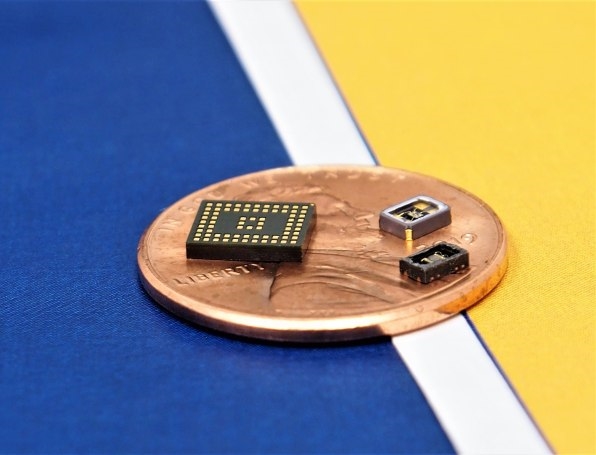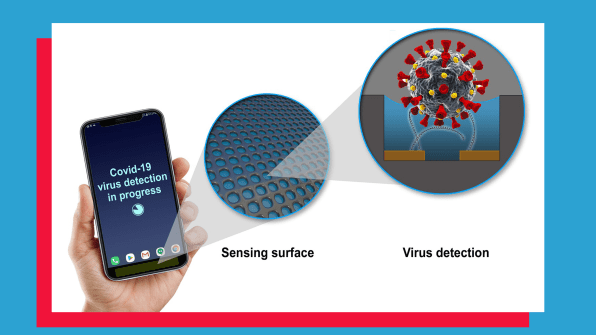GE is developing a COVID-19 detector that can fit inside an iPhone
Is there COVID-19 on this train car? Is there COVID-19 in this restaurant? Is there COVID-19 at this grocery store? Is there COVID-19 . . . in me? These are the questions we’ve been asking ourselves every second of the day over the last year of this pandemic, ever fearful of an invisible enemy that could be floating in the air anywhere.
But soon, we might never have to ask ourselves such questions again. That’s not because vaccines are here to stop COVID-19 in its tracks. That’s because General Electric (GE) is developing a potentially groundbreaking new sensor, which can fit into everyday electronics like smartphones and smart watches, to detect specific viruses or bacteria in the air, on a surface, or on your breath.

And it wouldn’t just work for COVID-19, either. GE’s chip could be optimized to detect a seasonal flu or the next pandemic coming our way, too.
“I call that in several months, COVID stories will be boring because everything is safe,” says Radislav Potyrailo, principal scientist at GE Research, with a small laugh. “But there will still be other particles to be detected.”
The news comes as GE has been awarded a two-year research grant with the National Institutes of Health (NIH) to create a new type of COVID-19 detector. (The work builds on two papers that Potyrailo’s team has already published.) While detecting a virus like SARS-CoV-2 can work a few different ways, it generally requires large lab equipment and a considerable amount of sampling. Even a nasal swab can sometimes fail to capture enough individual virus particles to be spotted by modern methods.
But with GE’s sensor, Potyrailo hopes to be able to detect just one.
So how does it work? The sensor is a microchip that’s smaller than a dime. At its deepest layers are nanowells, or super-tiny pores that are so small, only viruses and other extremely tiny particles can make their way inside. At the base of those channels is an organic solvent—think of it like a molecular glue—which is specifically customized with certain nucleic acids to make SARS-CoV-2 stick. That means each chip is customized for one virus (though GE is considering how a chip could detect multiple viruses, too).
When something sticks, the chip uses an electrode at the base of the well to shoot electricity into the object. This creates a natural electrical impedance, which just means the resistance of electricity flowing through any substance, which can be very precisely measured. (Check out this vintage research from Disney that leverages electrical impedance to turn plants into touchscreens!) That measurement indicates if it’s a COVID-19 virus or not.

Building this system is hard, not only because it’s new, but because, as Potyrailo admits, there are all sorts of other small particles in the air all the time, from pollen to flakes of skin. The chip must detect only the right particles, which means its physical structure must be designed to keep larger contaminants out.
But assuming GE can build a prototype in two years, as Potyrailo believes it can, he imagines all sorts of ways such a sensor could be squeezed into our lives. It’s possible that phones and smartwatches could have such a chip on board, exposed to the air at all times. So if you were in an infected area, your watch could passively capture SARS-CoV-2 and tell you.
He also imagines the chips making their way into specific contexts, like grocery stores or hotel rooms, where it would work as another part of the infrastructure to ensure public safety. There’s plenty of precedent for this idea in carbon monoxide detectors, which also identify otherwise undetectable threats in our environment. Potyrailo believes that drones would make excellent virus detectors, as they could fly through a space and sample a lot of air quickly. Now, it’s easy to imagine such a sensor causing public alarm. If you were to spot a single SARS-CoV-2 virion in a 100,000-square-foot retail store, would you immediately shut it down? But at the very minimum, such detectors would let us identify potential hot spots both constantly and proactively, rather than days or weeks later as people get sick and we must trace outbreaks back to their source.
Finally, Potyrailo floats that perhaps the chip would even be available in low cost, disposable formats. He suggests that a straw connected to such a chip could detect COVID-19 on your breath as a super simple self-test.
The big remaining question about any of these potential use cases and contexts comes down to how long GE’s sensor could operate before it’s unreliable. When I suggest that a chip topped with these organic compounds (in this case, nucleic acids) seems bound to decay quickly, he counters that the LCD screens in our laptops and televisions also make use of organic compounds, and they hold up quite well. He certainly believes that given our propensity to upgrade our phones every few years, they could be an excellent candidate for the lifespan of a virus detector.
Indeed, the more important question may be, not can we fit a virus detector into a phone, but is that effort actually worthwhile for any single virus? Because while Potyrailo suggests that one day this sensor might be built to detect multiple viruses—from the seasonal flu to COVID-19 at the same time—for now, GE’s focus is simply on detecting one reliably.
Though I’ll be the first to admit, if there was a COVID-19-detecting iPhone released in 2020, I would have been the first in line to buy it.
(20)



